 | E-mail to Birds Korea |
 | KWBS |
in the Region
 | The Oriental Bird Club |
 | BirdLife International (Asia) |
October
Warm (typically between 15-20°C mid-month), with often excellent birding weather: dry, sunny, and relatively calm. Occasional rain, although uncomfortable for birdwatchers, can produce excellent falls. One of the best times to be birding in Korea!
Autumn migration is in full swing, and anything is possible! Black-faced Spoonbill and Chinese Egret are still reasonably widespread. Hooded and White-naped Cranes start moving south into Korea, with several thousand in the DMZ. Huge concentrations of Tundra Beans and Greater White-fronted Geese form at the Han-Imjin and Seosan. The charismatic Baikal Teal arrives in force mid-month, with up to 200 000 at Seosan! Raptor migration is often strong, with Grey-faced Buzzards (day peak of 1 500 on Gageo island), Oriental Honey Buzzards, the occasional eagle (especially Greater Spotted), Northern Hobby, and the odd Amur Falcon.
Shorebirds are still present in good numbers and diversity, with a peak in Nordmann's Greenshank. Visible migration peaks with Olive-backed Pipits becoming very numerous by mid-month along the west coast, plus excellent numbers of buntings and flycatchers. Pale, White's, and small numbers of Dusky Thrushes are also on the move, along with the first of the typical winter passerines, Brambling and Siskin.
(The following records are a compilation of our own sightings and records sent in by other observers. As well as being posted on the Birds Korea website(s), selected records are also forwarded to other Korean-language birding websites; records of threatened species are arranged and forwarded to Birdlife International and national authorities when appropriate; flag images and records are passed to bodies responsible for their coordination throughout the flyway; and all records sent to us are used to compile annual reports and to support the evolving understanding of the status of many of Korea’s birds.)
Upo ramsar site, October 29-30
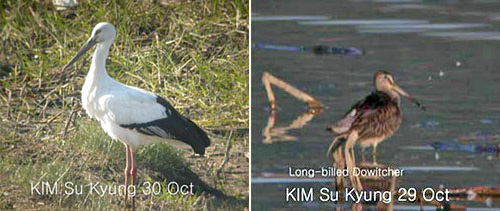
Upo Wetland, ©Kim SuKyung.
1 Oriental White Stork,
1 Long-billed Dowitcher,
35 Hooded Crane
(circling for 30min, not landing),
1600+ Taiga Bean Geese,
1500+ Ducks sp.
Socheong Island, AM, ferry back to Inchon PM, October 30
Only 5 hours in the field before catching the ferry back to the mainland - but some fantastic birding again.
Rarest were 2 more Dark-throated Thrush seen shortly after dawn, while most impressive highlight was a massive movement of Coal Tit, with a staggering 3 200 counted moving west/northwest out to sea in only one hour (between 0800 and 0900)! The largest group contained 380 individuals, while other smaller flocks carried a few Great Tit, a total of 5 Long-tailed Rosefinch, and up to 10 Siberian Accentor...the passage continued unabated for at least 3 hours, so it seems highly probable that at least 10 000 Coal Tit were involved...
Other good birds recorded on the island in the morning included at least 8 Bullfinch, 250 Yellow-throated Bunting, a Japanese Reed and probably 2 Pine Bunting, a late Mugimaki, and ca 30 Dusky and Naumann's Thrushes.
From the ferry, yet another South Polar and 12 Pomarine Skuas.
Socheong Island, October 29
An amazing morning's birding.
Highlights included 4 Scaly-breasted Munia (found in the far east of the island, these individuals - sunning themsleves and roosting in a tight ball, apparently to keep warm- were either part of the original group of 7, or a new group containing 1 adult and 3 immatures), a first year male Red-throated Thrush, a male "red" Common Rosefinch, Long-tailed Rosefinch, an adult Upland Buzzard, single Pied and Hen Harrier, 2 Long-eared Owl, 4 Asian House Martin, 25+ Siberian Accentor, and 2 very late Ashy Minivet.
Most intriguing, however, was a very white-looking owl, which was watched briefly hunting along the side of the road ca 30 minutes after sunset...due to the very poor light, views were insufficient to make a firm identification, but the bird's overall shape and coloration strongly suggested Barn Owl (a taxon as yet unrecorded in Korea)...
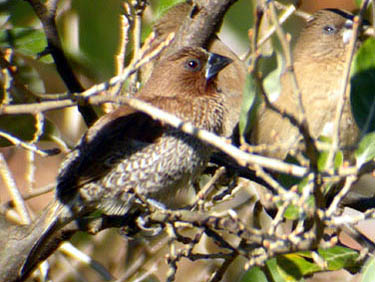
Photo © Nial Moores
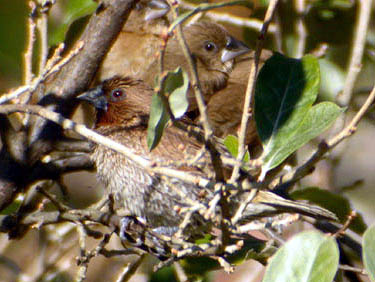
Photo © Nial Moores
Hong Island, October 28
Remarkably (following yesterday's records), after strong winds 4 Scaly-breasted Munia were observed on Hong Island by Park Jong Gil (the finder of Korea's first Isabelline Wheatear, on Daeheuksan on May 1st this year).
Hong Island is about 400km south of Socheong Island (which is towards the top of the Yellow Sea), and part of the same group of islands as Daehuksan and Gageo.
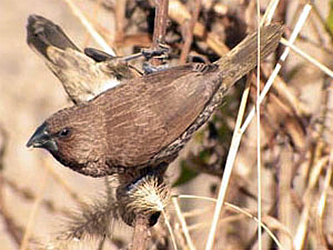
Photos © Park Jong Gil
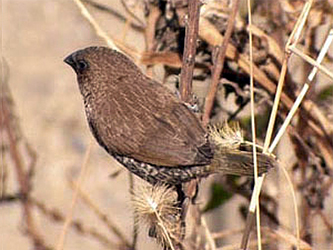
Photos © Park Jong Gil
Socheong Island, October 27
Force 6-8 SW winds (increasing through the day, and culminating in a three hour thunderstorm during the night) prevented much useful time in the field - with most birds being extremely difficult to see well. Numbers of most species therefore appeared well down, with few birds of note, excluding a single White's Thrush and ca 4 Red-flanked Bluetail, being found until ca 4pm...
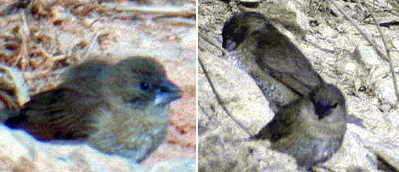
The Scaly-breasted Munia is typically found in scrub and secondary growth from the Indian subcontinent across southern China and Taiwan, and through the Sundas and Sulawesi. A common resident throughout most of its range, the species has been widely introduced to Indian Ocean islands and Australia.
Most obvious highlight of the day therefore was a group of seven small passerines which moved east in a tight group hurriedly along a sheltered cliff-slope. Even brief views confirmed that they were munia (Lonchura) sp (presumably an unrecorded genus in Korea), but it took a further 30 minutes of searching before the group was re-found, feeding and perhaps dust-batheing on a track about 800 m east of the original sighting. Brief views and some very poor digi-scope record shots were taken - and their identity confirmed as a group of seven Scaly-breasted Munia Lonchura punctulata, with two adults and the rest juvenile-immature types.
This is presumably a first record for the Korean peninsula, and surely amongst the most northerly record ever of this species in the wild? Any comments as to the subspecies involved (most likely topela - a black-billed race with yellowish uppertail-coverts found in China and Taiwan - though there is no consensus on how to clearly differentiate the many and varied taxa) or their mapped distribution in China would be greatly appreciated.
Songdo (freshwater lagoon), October 27
Winter ducks have arrived in force: Common Teal have built up to 1400, along with new arrivals of 500 Common Pochard, 4 Pintail, and 12 Shoveler. Wader numbers are right down: 30 Common with 2 Spotted Redshanks, 3 Common Sandpipers, and 55 Common Greenshank. Great Cormorants down to 250. On the lagoon, a lone Saunders', 7 Vega, and 1 Black-headed Gull. In an overgrown tree grove near the lagoon, a single Eye-browed Thrush.
Socheong Island, October 26
Calm and sunny conditions through the morning, with increasingly strong southwesterlies by late afternoon. 67 species logged, including some excellent species, though overall numbers of birds perhaps down from the day before. Once again, Coal Tit was the most numerous species, with probably ca 500 remaining.
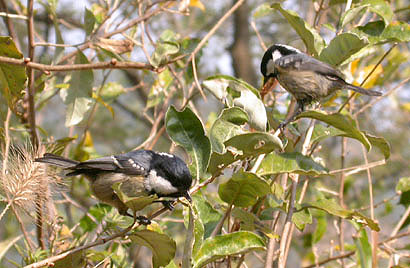
These were joined by at least 40 Great, and as many as 25 White-headed Long-tailed Tits. 8 species of bunting were also logged during the day, with most numerous being Yellow-throated (65+) and Black-faced (45), but including 1 rather late Yellow-browed Bunting. Other late migrants included another juvenile Pied Harrier, 2 Oriental/Crested Honey Buzzard, and single Ashy Minivet and Yellow Wagtail. Yellow-browed Warbler remain widespread, with ca 60 present, joined by 5+ Pallas's Leaf Warbler and 1 or 2 presumed Hume's Leaf (1 seen well as well as heard), along with 14 Dusky and 4 Korean Bush Warbler (could these late birds include more northern breeding individuals, perhaps even from Sakhalin?). Other species/counts of note include at least 26 Daurian Redstart, 2 Red-throated/Taiga Flycatcher, 8 Dusky and 3+ Grey-backed Thrush, and probably best bird of the day, 2 Dark-throated Thrush. Seen only in flight, at least one appeared to be a full adult male Black-throated, with the second being most likely a first winter male.
Okku, October 26
Highlights included seven Eurasian and two Black-faced Spoonbill seen both in salt pans and on adjacent flats, with Marsh Sandpipers and a Black-winged Stilt.
1 Eurasian Bittern and Eastern Marsh Harrier flying over the reedbeds.
Socheong Island, October 25
Largely clear conditions, with light northwesterlies continuing. Raptor passage remained strong in the morning, with probably 100 Common Buzzard through, along with 10+ Northern Goshawk and 5 Black Kite, while grounded migrants included an estimated 750 Coal Tit! Other species of note included 1 Great Cormorant in amongst 15 Temminck's, 3+ Red-throated/Taiga Flycatcher, a dead Lanceolated, a very late Arctic Warbler, a high count of 120 Yellow-browed Warbler, 8 Dusky and 8 Pallas's Leaf Warbler, 8 White-headed Long-tailed Tit, 2 Common Rosefinch and the personal first 2-3 Pallas's Rosefinch of the autumn.
Ferry and Socheong Island, October 24
The ferry yet again provided great interest, with several geese, ducks and shorebirds watched moving south or southwest over the sea, as well as 6 Pomarine and a single South Polar Skua (very poorly photographed, perhaps the first record shots of this species in Korean waters?), and 600+ Black-legged Kittiwake. Best of all - and least predictable, were two shorebirds watched flying southward, at closest within 50 meters of the ferry - both Asian Dowitcher!
With persistent northwesterlies and rapidly falling temperatures, good movements of migrants can be expected. On Socheong therefore, raptors included 22 Northern Goshawk and 44 Common Buzzard west in only 2 hours, as well as 4 Crested Honey Buzzard, 2 Black Kite, the personal first Upland Buzzard of the autumn and a lone Amur Falcon. Over 250 Brambling also moved west in 2 hours, along with many Coal Tit (counts of over 200 grounded in the west of the island alone). Other grounded migrants included ca 8 White-headed Long-tailed Tit, 40+ Yellow-browed and 15 Dusky Warbler, as well as small numbers of 6 bunting species (commonest being Yellow-throated with 45+ seen in the afternoon).
Gumi, October 24
134 Hooded Crane arrived at 16:30.
Gumi, October 23
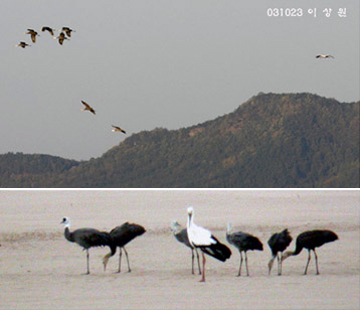
7 (4 adults, 3 juvenile) Hooded Crane, 1 Oriental Stork.
At 19:00, a further 73 Hooded Crane (leaving with the previous 7 individuals at 10am on 24th Oct).
Joonam Reservoir, October 23
1 White-naped Crane.
Seosan, October 23
2 Hooded Crane.
Upo wetland, October 23
Rather strong wind (3-4), No cloud cover, very nice weather for migration.
1300 Taiga Bean Geese, 500 Baikal Teal, 6 Eurasian Spoonbill, 6 Black-winged Stilt, 17 Dunlin, 2 Spotted Redshank, 30+ Common Snipe, 3000+ Ducks (Pintail, Falcated Duck dominated).
Seosan, October 19
1 Water Rail, 2 Purple Heron
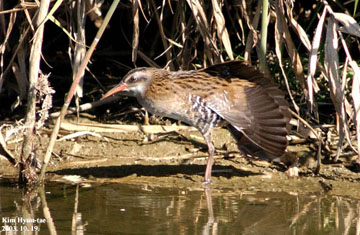
Photos © Kim Hyun-tae
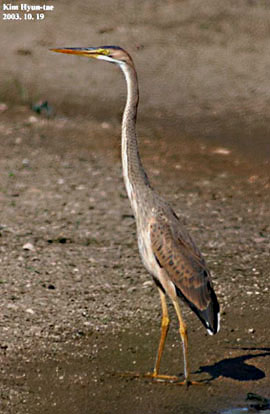
Imjin estuary (near Odu mountain), October 19
870 Swan Geese including 6 banded individuals: (Blue color rings - R9E, R91, R93, R95, R96, R99); 5 banded Swan Geese previously observed by Mr. Kim Kyung Won (Korean Wetland Alliance) on 9th Oct.
Gumi, October 19
11 Hooded Crane.
Cheorwon Basin, October 18
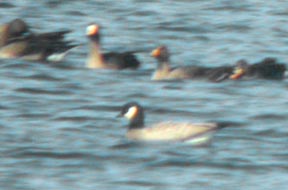
Photo © Nial Moores.
Restricted access still allowed excellent views of c 300 White-naped Crane, 1-2 White-tailed Eagle and huge numbers of Greater White-fronted Goose - a single roost contained at least 40 000 individuals! An hour scoping this massive flock led to the discovery of only 9 Thick-billed and one Eastern Taiga Bean Geese mixed in, along with ca 15 Baikal Teal and best of all between 5 and 7 "Cackling" Canada Goose. Watched well (though distantly), all but one were adults, and all but one appeared to belong clearly to the dimunitive subspecies minima.
"Cackling" Canada Geese (B.c. minima) are the smallest subspecies of Canada Goose, usually weighing 3 to 5 pounds (1.4-2.3 kg), and have a distinctive high-pitched call. They nest only on the outer coast of the Yukon-Kuskokwim Delta in western Alaska and winter primarily in California's Central Valley. Spring migration takes them up the Pacific coast through the Alaska Range to the nesting grounds. Fall migration includes staging on the upper Alaska Peninsula for several weeks, then a trans-oceanic flight to Oregon and California. Through the 1970s and early 1980s, overharvest and nest predation reduced the population from over 350,000 to about 30,000, but through a cooperative management effort among wildlife agencies and user groups from Alaska to California, "cacklers" rebounded to 160,000 by 1993 and are increasing.
Danyang, October 17
A Brown Hawk Owl is currently (still present as of last night) hanging out in downtown Danyang, Chungbuk Do. It's sitting on powerlines that run along the street next to the waterfront park and making sorties into the park to grab moths that are attracted to the lights. You can get excellent views of the bird and until the supply of moths runs out it seems to be quite content to stay where it is.
Though not a particularly rare bird in Korea, it's probably one that is very difficult to see well: this seems like a great opportunity to get good views of one...
Imjin Estuary, October 17
107 White-naped Crane
Gwangneung Forest and River Area, October 17
Disappointingly no Solitary Snipe in yet, but still excellent views of one White-backed and 1 Grey-capped Woodpecker (the latter considered rare in South Korea), as well as a single Hazel Hen, 5 Long-billed Plover and a similar number of Japanese Wagtail, in addition to good numbers of migrants: a total of c 50 Yellow-browed Warbler were logged along with a single Two-barred Greenish and 2 Arctic Warblers, single Mugimaki Flycatcher, Red-flanked Bluetail and Siberian Rubythroat, and at least 20 Tristram's Bunting.
Seosan Lake A and B, October 16
Another very good day, with 106 species logged.
Highlights included spectacular numbers (and views!) of geese, with at least 38 000 serrirostris Thick-billed Bean, 300+ Eastern Taiga, 15 000 Greater White-fronted, and a single Snow Goose. Baikal Teal numbers were well down compared to the 11th, with "only" 59 000 counted in the evening - while other duck species had increased dramatically, with for example 6 000 Spotbilled Duck and 10 000 Northern Pintail.
Ditches and reedbeds seemed to be alive with passerines in the early morning: a stretch of little more than 500 m contained 3 Siberian Rubythroat, 2 Bluethroat, 2 Siberian Stonechat, up to 15 Black-browed Reed Warbler and at least 200 Yellow-breasted Bunting. Other good birds included 39 White Spoonbill, a Ruff, another juvenile-type Greater Spotted Eagle, 10 Chinese Penduline Tit, 12 Pechora Pipit and 10 Japanese Skylark.
Han-Imjin Rivers, near Munsan-Ilsan, October 15
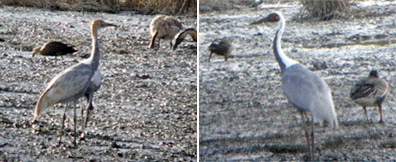
85 species logged for the day, with highlights including 30 White-naped Crane inland, with a further 96 on the Han River; 200 + Swan Goose; 2 000 Thick-billed Bean, 1 Lesser White-fronted in with 3 000 Greater White-fronted Geese; 32 Mandarin Duck, 14 Daurian Jackdaw, and a broad range of migrant raptors (12 species logged) and passerines. Best of the raptors were 5 Osprey, 1 Grey-faced Buzzard, 1 juvenile Pied Harrier, 1 Golden Eagle, and 2 Amur Falcon - including one stunning adult male first found by Paul - while passerines included 1000 Brambling, 100 Black-faced, 40 Rustic (personal first of the autumn), 20 Chestnut and 3 Tristram's Buntings, and single Rufous-tailed Robin and Siberian Rubythroat.
Yeongjong Island and Ganghwa, October 14
With light to moderate northwesterlies, migration was still much in evidence, and 104 species were logged in total.
On Yeongjong, the shorebird roost provided excellent views of several species - including Nordman's/Spotted Greenshank. While 8 Nordmann's were found in the roost itself, a total of 18 were counted together on the tidal-flat as the tide ebbed: this is probably one of the higher counts of the species anywhere in recent years. The same bay also held 1 Chinese Egret still, 2 000 Dunlin, 14 Ruddy Shelduck, and 31 Saunders's Gulls (comprising 30 first winters and only a single adult), while it was also overflown by one or more probably 2 migrant juvenile Greater Spotted Eagle. In the east of the island, a male Shrenck's Bittern (seen by Mathias), 3+ Rufous-tailed Robin and 6 White Spoonbill were found, while on Ganghwa highlights included 55 Black-faced Spoonbill, 3 Chinese Egret and 130 Saunders's Gull.
Socheong Island-Incheon, October 13
Strong overnight winds subsided during the morning, but were forecast to return on the 14th, leading the group to decide to return early to the mainland.
In 'light" birding in the morning, good numbers of grounded migrants included 1 Oriental Scops and 1 Brown Hawk Owl, 15+ Grey-backed Thrush, 5 Pallas's Leaf, 3 Arctic and 60 Yellow-browed Warblers, 25 Chestnut-flanked White-eye (proving the species' status as a locally common migrant on western islands in autumn), 60 Chestnut and 40 Black-faced Buntings, while strong overhead raptor migration continued. In only 2 or 3 hours 2 Crested Honey Buzzard, 6 Black Kite, 35 Grey-faced Buzzard, 30 Japanese Sparrowhawk, 10 Northern Sparrowhawk, 3 Goshawk, 8 Buzzard, 2 Kestrel, 1 Amur Falcon, 1 Hobby and 3 Peregrine were logged, along with an adult Eastern Imperial Eagle.
The sea also provided much interest with the first White-winged Scoter of the trip logged, along with ca 250 Streaked Shearwater. The ferry journey produced 1 Short-tailed Shearwater, 4 Arctic and 36 Pomarine Skuas (the latter clearly proving to be by far the commonest skua in South Korean waters along both the east and west coasts), 1 Finless Porpoise, and one dark grey unidentified cetacean with a long, swept back dorsal fin.
Incheon-Socheong Island, October 12
Overcast conditions with rain produced a few interesting migrants, despite the wind remaining stubbornly in the east, preventing seawatching for some of the journey out. Among many highlights from the ferry was a single South Polar Skua (along with 8 Pomarine and 3 Arctic Skuas) seen well by all of the group, though a less well-seen Swinhoe's Storm Petrel was equally well received, while several small flocks of pipits and other passerines out to sea also provided much interest.
On Socheong itself, best were 3 Pied Harrier (all juveniles), a Japanese Wagtail (mapped very inaccurately in Lee, Koo and Park, this is quite a widespread nesting species in South Korea, even occurring on the outskirts of Seoul: could they also be nesting in North Korea?), and off from the lighthouse a flock of at least 334 "Pacific" Black-legged Kittiwake attended by 25 more Pomarine and 2 Arctic Skuas.
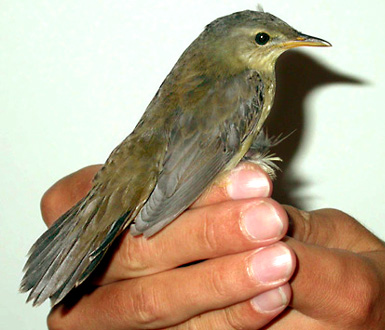
This photo was taken by Dave on Sept 28th and just received. As we reported in September's Latest Bird News:"...Back in Gunsan, we went to a local restaurant for a late dinner where Dave noticed a bird fluttering among the tables: it was nothing less than a disoriented Middendorff's Grasshopper Warbler! Caught in mid-flight by Mathias, it was then well-photographed (and ticked by at least 3 in the group) before being released into a dark patch of nearby woodland."
Song Do, October 12
SONGDO "ketpul" (ie tidal-flat).
Explored the far right end of the seaside park. Ran the gauntlet of security guards and developers, was chased out of the main area of destruction (=development). This far end has a channel going inland, and appeared to have a good variety of water/shorebirds:
Chinese Egret 9, possible Relict Gull 2 (birds very distant), Slaty-backed Gull 2, Grey-tailed Tattler 2, Lesser Sandplover "plenty", Pacific Golden Plover 3, Little Ringed Plover 2, Far eastern Curlew c. 15, Eurasian Curlew 5, Dunlin "plenty", Red-necked Stint "numerous", Terek Sandpiper c200, Black-tailed Godwit 10.
SONGDO Lagoon:(nr. Dongmak).
Saunders Gull 19, (including 4 1st winter), Marsh Sandpiper 4, Common Greenshank "plenty", Buntings 100+ (unidentified), Blue Rock Thrush 1,
Common Teal 300 (less than on previous visit), Great Cormorant 250 on the island roost. (The huge numbers of cormorants of last week may have dispersed southwards, as this weekis probably the last warm one before winter.
Heavy rain stopped play at 5pm!
Taehuksan am, Seosan Lake A pm, October 11
"Only" a single Nordmann's Greenshank found on the inner Dongjin in the morning, along with 400 Common Greenshank and 2 000 Black-tailed Godwit still.
On Taeheuksan in the morning, before catching the ferry back to the mainland, 1 very confiding Baillon`s Crake still, 1 Pechora Pipit, ca.25 Pale Thrush, ca.100 Brambling, ca.5 Chinese Grosbeak and 8+ extremely late Pacific Swift.
At Seosan, whole group treated to spectacular views of a minimum 180 000 Baikal Teal, whooshing low over our heads in dense clouds at dusk, to the backdrop of 15 000- 20 000 calling Thick-billed Bean Geese...
Daeheuksan Island, October 10
Some excellent birds, including an apparent Elisae'sor Beijing Flycatcher (perhaps first multi-observer record in South Korea?) and a "Red-throated" Thrush.
Yeongjong Island, October 10
A few hours of birding in the afternoon produced several excellent birds, including: 4 Chinese Egret in the north and perhaps 14 in the south of the island; 1 Black-faced Spoonbill in the north and 6 in the south; 500 Falcated Duck; and 2 Pechora Pipit and a single Siberian Rubythroat. The shorebird roost, visited as birds were moving off it, still contained at least 500 Far Eastern Curlew, 500+ Great Knot, and best of all 4 Nordmann's Greenshank.
Daeheuksan Island, October 9
A good range of birds included at least 2 Baillon's Crake (seen excellently), 1 Schrenk's Bittern, 1 Greater Spotted Eagle, a single Baikal Teal and 5 Mandarin Duck. In addition, more typical migrants for the southwestern islands included 2 Chestnut-cheeked Starling and "many" Pale Thrush.
Gageo Island am, Daeheuksan Island pm, October 8
On Gageo, the autumn's first Long-tailed Shrike (apparently an annual visitor to the island, with at least 3 in October 2002), while from the ferry to Daeheuksan very few birds - best being a single Streaked Shearwater!
On Daeheuksan in the afternoon, 1 Chestnut-cheeked Starling and 1 Yellow-legged Buttonquail (a significantly overlooked migrant, recorded mostly on western islands in autumn).
Gageo Island, October 7
A disappointing day, with easterly winds and temperatures reaching ca 24C at maximum. Raptors were very evident, with ca 40 Crested Honey Buzzard and 600+ Grey-faced Buzzard, but very few grounded migrants were in evidence. Only 10 Chinese Grosbeak, single Black-faced and Chestnut Bunting, 2 Lanceolated Warbler and 1 Grey-streaked Flycatcher were logged.
Of most interest therefore were 1 Japanese Quail, several Richard Pipit and seven swifts, with one group of 4 definite very late Pacific Swift being followed by a second group of 3 birds that did not appear to show white rump-bands. There are no confirmed records of Common Swift Apus apus in South Korea, even though the species breeds as close to Korea as Beijing: several birds have been seen in late autumn in previous years that similarly appeared not to show white rump bands.
Daeheuksan-Gageo Island, October 6
In the morning, further good views of Pechora Pipit on Daeheuksan, as well as 2 Mandarin and 2 Falcated Duck, single Lanceolated Warbler and 20-30 Japanese White-eye.
Few seabirds from the ferry between the two islands, but instead a very large flock of ca 2000+ Red-necked Phalarope (possibly the highest count of this species in South Korea in recent years?).
On Gageo's disturbed southern end, no buntings heard or seen at all, and rather few migrants logged. Best were 170+ Grey-faced Buzzard, 4 serrirostris Bean Goose, 1 Red-throated Flycatcher (much scarcer in the southwest than the northwest), and several Brown and Grey-streaked Flycatcher, several Dusky and Arctic and another Lanceolated Warbler.
Other more Japanese type species were "many" Japanese Bush Warbler, at least 5 Japanese White-eye, and best, 1 Black Woodpigeon: a very scarce and local breeding species in South Korea.
Mokpo to Daeheuksan Island, October 5
On Daeheuksan, good numbers of migrants included 'lots of buntings", 100 Chinese Grosbeak, 3 Grey-streaked Flycatcher, Wryneck and close views of Pechora Pipit.
Han-Imjin and northern Yeongjong Island (0700-1200), October 5
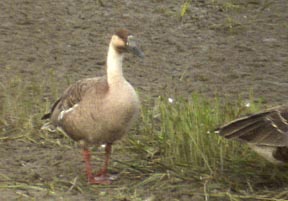
The last few hours of birding before their 2pm flight produced some excellent views of at least 200 Swan Goose on the Han-Imjin, along with ca 3 000 serrirostris Bean and 2 000+ Greater White-fronted Geese. Further surprises came in the form of at least 4 Lesser White-fronted Goose in flight with another one on the tidal-flats, and 3 early White-naped Crane (2 ads with a very young looking juvenile), as well as 15 distant spoonbills.
On Yeongjong, single Red-throated Flycatcher and Arctic Warbler were in coastal bushes along with plentiful Black-faced Bunting, with 1 Black-faced Spoonbill and 2 Chinese Egret on the northern tidal-flats. Biggest surprise and best bird of the morning, however, was an Oriental White Stork, which landed briefly, before thermalling away over the airport runways!
Yeongjong and the Han-Imjin, October 4
Two hours at Song Do tidal-flat produced 4 Saunders's and 1 Slaty-backed Gull and at least 14 Chinese Egret still.
In the afternoon, the highlight of birding on Yeongjong was a flock of 34 Black-faced Spoonbill on the southern side, followed by a further 8 in the north-east, feeding in fish ponds with 1 White Spoonbill. On the Han-Imjin, 60 Swan Goose, and at least 1 Lesser White-fronted Goose seen and heard in flight, with other species of interest there including 4 Ruddy Shelduck, 3-4 White Spoonbill and 2 Black-faced Spoonbill, as well as ca 50 Black-faced Bunting and 2 Korean Bush Warbler in a single 200 m stretch of bushes and reeds.
Sacheon Myon in Gangneung, October 3
40 Russet Sparrow, 1 Collared Dove.
Socheong am - Ferry back to Incheon pm, October 3
Clear evidence that bunting migration is now getting properly underway in South Korea, with ca 50 Chestnut and 60 Black-faced Bunting logged in the morning (along with the first Brambling of the autumn). Raptor migration also still at its peak, with 3 Osprey, 40 Crested Honey Buzzard, 20 Grey-faced Buzzard, 12 Black Kite, 1 juvenile Pied and 1 Eastern Marsh Harrier, 1 Chinese Sparrowhawk, 40+ Japanese Sparrowhawk, 5 Northern Sparrowhawk, 15 Northern Goshawk, 10 Common Buzzard, 2 Kestrel, 1 Amur Falcon, 3 Northern Hobby and 2 Peregrine logged between 0700 am and 1300.
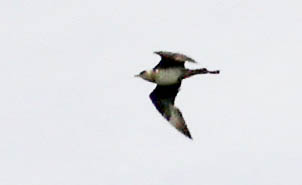
Other species of note included 5 Rufous-tailed Robin and 10+ Siberian Rubythroat (several of both allowing close, prolonged views), 3 + Grey-backed Thrush, 4 Red-throated Flycatcher still, 10+ Chestnut-flanked White-eye seen well, and at least 5 Common Rosefinch.
From the ferry, only 15 Streaked and 1 Short-tailed Shearwater, but 9 Pomarine (including one well-photographed), and 3 Arctic Skua, as well as 8 Black-legged Kittiwake and 2 Chinese Egret near Incheon harbor.
Socheong Island, October 2
With the wind still in the north-west, and visibility increasing to ca 100 km, this was an excellent day, with about 80 species logged, including no less than 16 species of raptor (including single Pied Harrier and Amur Falcon), many seabirds close in (including 500+ Streaked, single Flesh-footed and 2-4 Short-tailed Shearwaters, single Arctic and ca 8 Pomarine Skuas), much improved numbers of commoner migrants (including 150+ Yellow-browed, 5 Raddes, 5 Dusky and 15 Arctic Warbler) and a good spread of scarce migrants. Of these highlights included 1 Painted Snipe, 1 Asian House Martin, 1 Little Swift, 1 Gray's Grasshopper Warbler (flushed by Dave Parmenter) 8 Red-throated Flycatcher (a South Korean new peak count?), 10+ Chestnut-flanked White-eye (with 15 other White-eyes also presumed to have been this species), and 3 Common Rosefinch.
Good "dates" included 12 very late Pacific Swift, and 1 early Dusky Thrush (eunomus subspecies), while species of the day were single Tree Pipit (Manuel Schweizer and Paul Walser), and juvenile Black Stork. Both of these are now being recorded annually in South Korea - the latter along the west coast in October, with occasional birds attempting overwintering.
Seosan, October 1
200+ Red-throated Pipit (and several Pechora Pipit)
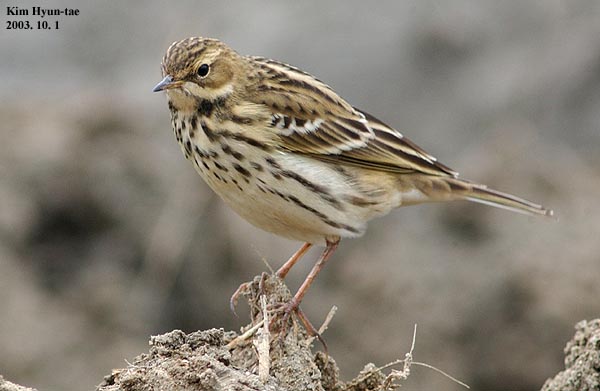
Incheon - Socheong Island, October 1
The planned trip out to Eocheong was cancelled due to the present "development" work there, with the team opting to visit the more peaceful Socheong again.
In overcast and sometimes stormy conditions, the ferry crossing again produced some excellent birds - including at least 1 South Polar, 5 Arctic and 7 Pomarine Skuas, 1 Short-tailed and 80+ Streaked Shearwaters, 12+ Taimyrensis gulls and an Ancient Murrelet.
On the island overnight light rain had dropped a few migrants, including 4 Lanceolated, 10 Arctic and 100+ Yellow-browed Warblers, 2+ Red-throated and 2 Blue-and-White Flycatchers, 4 Siberian Rubythroat and the personal first Red-flanked Bluetail and Rufous-tailed Robin of the autumn. Raptor passage remained strong too, including a single Amur Falcon perched up on telephone wires and 10 + Osprey moving southwest.
Birds Korea 1108 Ho, 3 Dong, Samick Tower Apt., 148-22, Namcheon-Dong, Su-Young-Gu
Busan, 618-762 Republic of Korea





